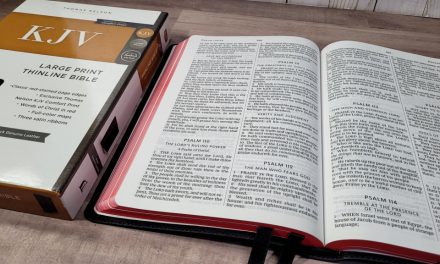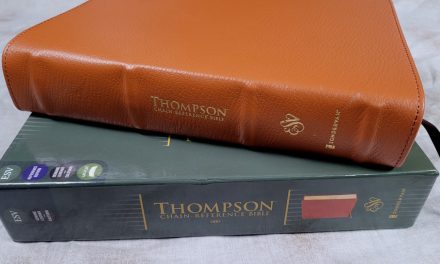The Amplified Study Bible is unique in that it provides a way to study the nuances and meaning of words without having to learn the original languages. The Amplified translation was recently updated. The Amplified translation gives you study tools within the translation itself. It’s a literal translation that uses synonyms and definitions to explain or expand words in the text. In this review I take a look at the latest version of the Amplified Study Bible.
ISBN: 9780310440307
_________________________
_________________________
The Amplified Translation
The Amplified translation gives you a range of words that are alternative to what’s in the text to help in understanding the text. It also gives historical and theological explanations on the text. The updated edition includes more amplifications in the OT and has refined many of the amplifications in the NT. The text has also been improved so it reads smoother than before.
The advantage of this comes from the Greek and Hebrew words having a range of meaning and there isn’t always a perfect word in English to translate it into. You can see this range of meaning without having to know Greek or Hebrew.
Binding
This edition is hard cover. It has a dust jacket with the typical features list. The actual cover is red with gold text. The binding is sewn and lies open perfectly at any page. The overall size is 9.5 x 6.5 x 1.8”
Paper
The paper is thin and decently opaque. It doesn’t glare under direct lighting. I had no issues turning pages. It’s white in color and has the kind of texture that should be good for marking with most standard Bible marking tools.
Typography
The text is presented in double-column verse-by-verse format with poetry indented for each line after the first line in each verse. Old Testament quotes are in all-caps and the reference printed at the end with some being set in poetic format. Commentary is placed in double-column under the text in a smaller font and references are placed in a box at the bottom of the page. The header shows the book name, chapter, verse, and page number in the outer corner.
The font is 10.5-point black-letter. It’s darker than most study Bibles and is easy to read. There are no footnote or reference keys within the text. Section headings are in bold. It has around 40 characters and around 8 words per line.
I like the references placed at the bottom. The text doesn’t have to share horizontal space, leaving more room and making the text more readable. The content within parenthesis and brackets do become distracting when reading though. In my opinion it’s better for study than for reading.
References
It does have quite a few references to help with study. Old Testament quotes and fulfilments are within the text. The standard cross-references are placed in the footer. Here’s a sample of references to help you compare:
- Genesis 1:1 – Jn 1:1,2; Heb 1:10; Ps 8:3; Isa 4:24; Ac 17:24; Rev 4:11
- Deuteronomy 6:4 – Jn 17:3; 1 Co 8:4,6
- Isaiah 9:6 – Isa 7:14; Lk 2:11; Jn 3:16; Mt 28:18; 1Co 15:25; Jdg 13:18; Titus 2:13; Eph 2:14
- Matthew 17:20 – Mt 21:21; Mk 11:23; Lk 17:6; 1Co12:9; 13:2
- Mark 11:23 – Mt 17:20; 21:21; Lk 17:6
- Mark 12:29 – Dt 6:4; Lk 10:27
- John 1:1 – Pr 8:22; 1Jn 1:1; Pr 8:30; Jn 17:5; 1Jn 5:7
- Acts 2:38 – Lk 24:47; Ac 3:19
- 1 John 1:1 – Jn 1:1, 14; 2 Pe 1:16; Lk 24:39; Jn 20:27
Book Introductions
Book introductions take about a half page and cover the author, time, key verses, and theme of the book. They’re short and help set the stage for the book and tell about their historical setting, culture, and major events.
Notes
It has over 5000 study notes with a focus on application. These are shown as snippets from the text in bold italics. They include information such as people, culture, places, and explanations about the events, etc. Most of the notes are this type of note. It also includes 330 theological notes. These are in bold followed by a dash. These are good for references, but as always I recommend you do your own study.
Charts show things like covenants, dates, people, between the testaments, parables of Jesus, miracles of Jesus, archaeological finds, etc. They are placed throughout the text. There aren’t a lot of them but those that are here are helpful for study.
The maps are annotated and printed in monochrome. They apply to the surrounding text and includes references. It also includes diagrams of synagogues and similar items.
It has two indexes in the back to the notes. The first places them in biblical order and the second places them in topical order. I’d like to see the maps and charts added to the index in the back to make them easy to find.
Topical Index
 Rather than a standard concordance it has a 161-page topical index. You would look up words like you normally would but instead of just a list of verses it has a list of sub-topics in an outline format. It also includes definitions and other topics for you to look up in the index.
Rather than a standard concordance it has a 161-page topical index. You would look up words like you normally would but instead of just a list of verses it has a list of sub-topics in an outline format. It also includes definitions and other topics for you to look up in the index.
The topical index of one of the best study tools in this Bible. It’s great for personal study and sermon prep.
Here’s s short list of words with the number of major topics and total number of entries. Each of these includes multiple sub-topics.
- Christian – 2 topics, 17 entries
- Faith – 7 topics, 99 entries
- Faithfulness – 3 topics, 48 entries
- God – 5 topics, 84 entries
- Praise – 4 topics, 51 entries
- Prayer – 7 topics, 154 entries
Maps
It has 14 full-color maps on 16 thick and glossy pages. Maps are annotated and include distance, possible locations of lost cities, journeys, topography, battles, routes, cities, borders, dates, places where biblical events took place, etc.

It also includes an index to maps. I’m glad this is included because it makes finding locations much easier.
Maps include:
- World of the Patriarchs
- Holy Land and Sinai
- Exodus and the Conquest of Canaan
- Land of the Twelve Tribes
- Kingdom of David and Solomon
- Kingdoms of Israel and Judah
- Prophets in Israel and Judah
- Assyrian and Babylonian Empires
- Holy Land in the Time of Jesus
- Jerusalem in the Time of Jesus
- Jesus’ Ministry
- Apostles’ Early Travels
- Paul’s Missionary Journeys
- Roman Empire
Conclusion
The Amplified Study Bible is a helpful tool for word-studies. It helps in understanding the range of meanings without having to learn Greek or Hebrew. It also provides information on the culture and setting. For notes it includes commentary, charts, and in-text maps. The study tools are concise, giving the most important information rather than trying to be exhaustive. The topical index is an excellent tool for personal study and sermon prep. Any fan of the Amplified translation or anyone wanting to gain insight on word-meanings will enjoy using the Amplified Study Bible.
_________________________
_________________________
Photography by hannah C brown
Zondervan provided this Bible free for review. I was not required to give a positive review – only an honest review. My opinions are my own.


































Thank you, Randy. Recognizing its strengths and weaknesses, I have long held a special place for the Amplified, because
it does in a straightforward way what others do not–laying out the hidden meanings and nuances of words and
phrases which are true in the originals, but invisible to us centuries later. I like the study aids they have added, and I
believe it will be worth my while to get a copy. I appreciate the review–very helpful !!
Thanks Dan!
Thanks Randy. One correction and it is a big one…this binding is not sewn but glued.
Hi Doug. The older editions are glued. This is the newest edition and it’s sewn. Here’s a picture of the threads.
Oops. sorry! It is sewn.
I apologize.
Thanks.
No problem. I should have included the picture to begin with. My daughter took a photo of the threads but I didn’t use it.
I keep trying to find this bible in a softbound version, or leather like. I thought this bible had already released, everyone seems to be out of stock or shipping sometime in June? I’m not sure. Can anyone clarify?
Hi Jen. It looks like it’s out of stock at Christianbook. It looks like Amazon currently has it in imitation leather:
Purple
Brown with Thumb Index
The amplified version was created by lockman foundation along with Zondervan. It is reported that Lockman was a mason. I was going to purchase it until I learned of the mason connection.
I am much more interested in the character, scholarship and practices of those who did this translation, than on F. Dewey Lockman. It appears that F. Dewey Lockman’s wealth was used to fund the NASB and AMP translations and not masonic enterprises. I know plenty of people who joined questionable organizations at one time or another in their lives only to repudiate them later in life. Use better reasoning, such as scholarship problems, difficulty with using/understanding/reading this translation for rejection. (I have a copy of the AMP in my collection. It’s not a favorite, because I find the format confusing.) He who is without sin, cast the first stone.
Do you know if the leather versions of this Bible have the same quality paper and binding as the hardcover verson?
Hi Gerald. I don’t know, but I can ask my contact at Zondervan.
Hi Gerald. I heard back from Zondervan. The paper in the hardcover and leather editions are exactly the same.
i think the contents of the study notes of this study bible are the same with nkjv or viv foundation study bible.
but the cross references of amplified study bible are much better.
i mean NKJV or the NIV Foundation Study Bible and this amplified study bible have the same study notes…..
is it wrong to let people drimk at our house
Hi Condo. Keep in mind that anything you allow can be perceived as approval. It would then be difficult to teach others against something that you allow to take place.